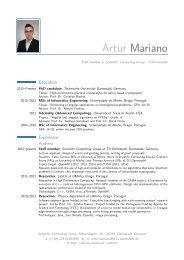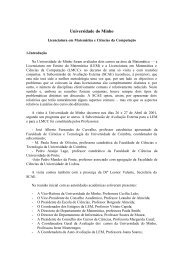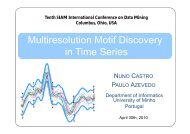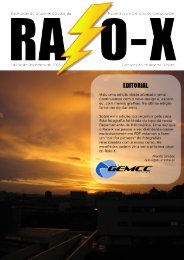Spreadsheet notoriously
Bidirectional Transformation of Model-Driven Spreadsheetsâ - ALFA
Bidirectional Transformation of Model-Driven Spreadsheetsâ - ALFA
- No tags were found...
Create successful ePaper yourself
Turn your PDF publications into a flip-book with our unique Google optimized e-Paper software.
12<br />
to (replicate M cn dir n inst) = replicate D dir cn n inst<br />
to (addClass M cn p 1 p 2 ) = ∅<br />
to (addClassExp M cn dir p 1 p 2 ) = ∅<br />
The first five model operations have a direct data transformation, that is, a<br />
transformation with the same name which does the analogous operation. An interesting<br />
transformation is perfomed by replicate M : it duplicates a given class,<br />
but not the data. Instead, a new empty instance is added to the newly created<br />
class. Another interesting case is the transformation of the model operation<br />
addClass M . This model transformation does not have any impact on data instances.<br />
Thus, to returns an empty set of data transformations. In fact, the same<br />
happens with the addClassExp M operation.<br />
We now present the from transformation, which maps data operations into<br />
model operations:<br />
from : Op D → Op ⋆ M<br />
from (addColumn D w i) =<br />
replicate M className Horizontal classInstances instanceIndex M<br />
; addColumn M w columnOffsetIndex M<br />
from (delColumn D i) =<br />
replicate M className Horizontal classInstances instanceIndex M<br />
; delColumn M columnOffsetIndex M<br />
from (addRow D w i) =<br />
replicate M className Vertical classInstances rowIndex M<br />
; addRow M w rowOffsetIndex M<br />
from (delRow D i) =<br />
replicate M className Vertical classInstances rowIndex M<br />
; delRow M rowOffsetIndex M<br />
from (setLabel D (i, j ) l) =<br />
replicate M className Horizontal classInstances columnIndex M<br />
; replicate M className Vertical classInstances rowIndex M<br />
; setLabel M positionOffset M l<br />
from (setV alue D (i, j ) l ) = ∅<br />
from (addInstance D cn dir m) = ∅<br />
The transformations in this case are more complex than the model-to-data ones.<br />
In fact, most of them produce a sequence of model operations. For instance, the<br />
first transformation (addColumn D ) results in the replication of a class followed<br />
by the addition of a new column. The argument classInstances is actually a<br />
function that calculates the number of data class instances based on the data to<br />
be evolved. On the other hand, the operation to set a value of a particular cell,<br />
setV alue D , does not have any impact on the model. The same happens to the<br />
operation addInstance D which adds a new instance of an expandable class. The<br />
definition of from for the (non-empty) data operations in the range of to (e.g.,<br />
AddColumn D , DelRow D ) is simply the inverse of to.<br />
4.5 Bidirectional Transformation Properties<br />
Since the aim of our bidirectional transformations is to restore the conformity<br />
between instances and models, a basic requirement is that they satisfy correct-







